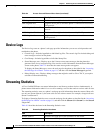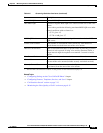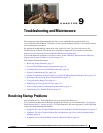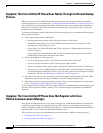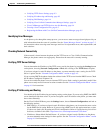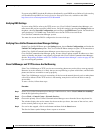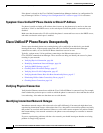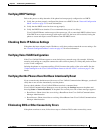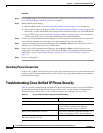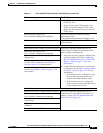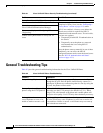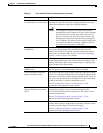
9-4
Cisco Unified IP Phone 7970G/7971G-GE Administration Guide for Cisco Unified Communications Manager 7.0
OL-15299-01
Chapter 9 Troubleshooting and Maintenance
Resolving Startup Problems
If you are using DHCP, check the IP addresses distributed by your DHCP server. Refer to Understanding
and Troubleshooting DHCP in Catalyst Switch or Enterprise Networks, available at this URL:
http://www.cisco.com/warp/customer/473/100.html#41
Verifying DNS Settings
If you are using DNS to refer to the TFTP server or to Cisco Unified Communications Manager, you
must ensure that you have specified a DNS server. Verify this setting by pressing the Settings button on
the phone, choosing Network Configuration, and scrolling to the DNS Server 1 option. You should also
verify that there is a CNAME entry in the DNS server for the TFTP server and for the
Cisco Unified Communications Manager system.
You must also ensure that DNS is configured to do reverse look-ups.
Verifying Cisco Unified Communications Manager Settings
On the Cisco Unified IP Phone, press the Settings button, choose Device Configuration, and look at the
Unified CM Configuration options. The Cisco Unified IP Phone attempts to open a TCP connection to
all the Cisco Unified Communications Manager servers that are part of the assigned
Cisco Unified Communications Manager group. If none of these options contain IP addresses or show
Active or Standby, the phone is not properly registered with Cisco Unified Communications Manager.
See the “Registering the Phone with Cisco Unified Communications Manager” section on page 9-5 for
tips on resolving this problem.
Cisco CallManager and TFTP Services Are Not Running
If the Cisco CallManager or TFTP services are not running, phones may not be able to start up properly.
However, in such a situation, it is likely that you are experiencing a system-wide failure, and that other
phones and devices are unable to start up properly.
If the Cisco CallManager service is not running, all devices on the network that rely on it to make phone
calls will be affected. If the TFTP service is not running, many devices will not be able to start up
successfully.
To start a service, follow these steps:
Procedure
Step 1 From Cisco Unified Communications Manager Administration, choose Cisco Unified Serviceability
from the Navigation drop-down list.
Step 2 Choose Tools > Control Center - Network Services.
Step 3 Choose the primary Cisco Unified Communications Manager server from the Server drop-down list.
The window displays the service names for the server that you chose, the status of the services, and a
service control panel to stop or start a service.
Step 4 If a service has stopped, click its radio button and then click the Start button.
The Service Status symbol changes from a square to an arrow.



